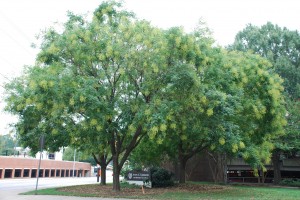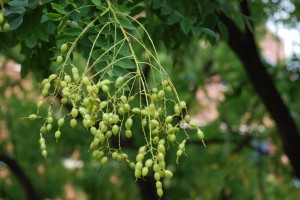U.S. east coast cities are finally planting Japanese Pagodatree (Styphnolobium japonicum). This medium-sized tree grows to 50 feet high, but 75 feet is not uncommon in the southeastern U.S. Pagodatree is native to eastern Asia (USDA hardiness zones 4 –8) where it is more known as Scholar tree. In the early 20th century it was frequently seen planted around schools and Buddhist temples in Japan.
Pagodatree grows in full to partial sun (6-hours minimum) and in a moist well-drained, slightly acidic soil. Pagodatree tolerates urban drought, air pollution, and moderate salinity around coastal areas. The tree has no serious disease or insect problems. A small number of cultivars, including weeping and upright (columnar) forms, are listed.
‘Regent’ is the most popular cultivar, high valued as a vigorous grower and lustrous green foliage. A newly planted tree blooms earlier and exhibits superior disease resistance than the species. Annual growth rate ranges from 18 to 24 inches. Summer foliage is comprised of 8-10 inch long, pinnately compound leaflets numbering 7 to 17. In some years its golden fall color can be spectacular.
What really makes pagodatree special is its July-August flowering time, when few landscape trees are blooming. Its pea-like, creamy-white flowers are showy and fragrant. Flower clusters, 12 inches long and wide, drape from branch tips. Another unique feature is the 3 to 8 inches long green “string of pearls” fruits which form in late summer and persist way into fall. Birds don’t appear drawn to the berries which shrivel to black and linger through the winter. By spring the tree has self-pruned many of the twiggy fruit rachises.
A young pagoda tree exhibits a semi-upright, vase shape habit and develops a full rounded canopy as the tree ages. A mature tree exhibits a lovely grayish-brown furrowed bark. Pagodatree is related to Mescal Bean tree (Calia secundiflora), native to Southern Texas into Mexico (Zones 8-10).



 Posted in
Posted in 
